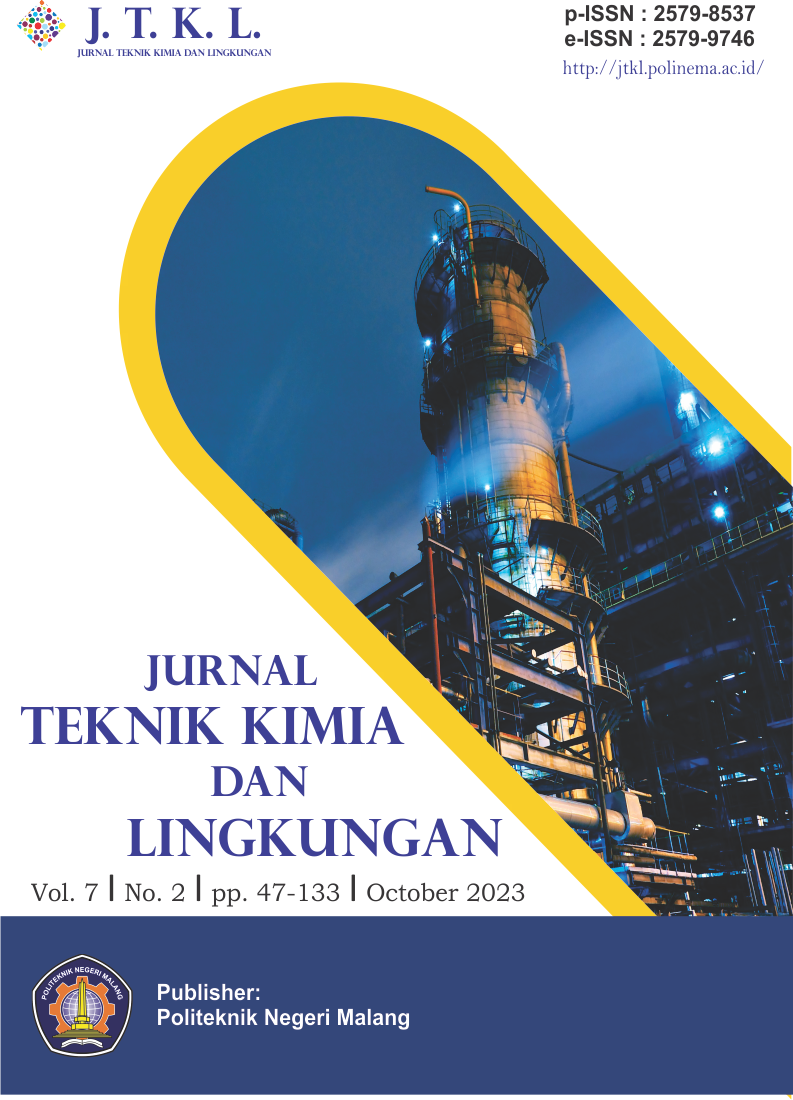The Potential of Cassava Peel Waste as a Material of Biodegradable Plastic using Calcium Silicate Filler
DOI:
https://doi.org/10.33795/jtkl.v7i2.1721Keywords:
biodegradable plastic, calcium carbonate, cassava peel, sorbitol, wasteAbstract
Biodegradable plastics are plastics that can be degraded and decomposed quickly by microorganisms in the soil. In this study, biodegradable plastic was made with starch from cassava peel waste, sorbitol as a plasticizer, and calcium silicate as a filler. This research was conducted to determine the effect of the amount of filler and the amount of plasticizer on biodegradation properties, tensile and elongation strength, and water absorption properties. The variables used in the plasticizer are 30%, 40%, and 50% (w/w) of the weight of cassava peel starch. While the variables used for filler are 1%, 3%, 5%, and 7% (w/w) of the weight of cassava peel starch. The results of the study showed that the highest biodegradation test results were 81.7% with 7% calcium silicate filler variables and 50% plasticizer sorbitol, tensile strength test obtained the highest value of 0.767 MPa on 3% calcium silicate filler variables and 30% sorbitol, elongation test with the highest value on the filler variable calcium silicate 7% and sorbitol 30% that is equal to 5.20% and the water adsorption test obtained the smallest value is 10.33% on the filler variable calcium silicate 1% and sorbitol 30%. The biodegradable plastic as a result of this research has met the standards for degradation ability based on the ASTM 6400 standard but has not met the standards for tensile strength, elongation, and water adsorption.
References
R. Krisnadi, Y. Handarni, K. Udyani, Pengaruh Jenis Plasticizer Terhadap Karakteristik Plastik Biodegradable dari Bekatul Padi, Pros. Semin. Nas. Sains dan Teknol. Terap., vol. 1, no. 1, pp. 125–130, 2019.
I. Winursito, Perkembangan Penelitian Dan Pemakaian Plastik Biodegradabel Di Indonesia, J. Ris. Ind., vol. 7, no. 3, pp. 251–262, 2013.
H. Hardjono, P. H. Suharti, D. A. Permatasari, V. A. Sari, Pengaruh Penambahan Asam Sitrat Terhadap Karakteristik Film Plastik Biodegradable Dari Pati Kulit Pisang Kepok (Musa acuminata balbisiana Colla), J. Bahan Alam Terbarukan, vol. 5, no. 1, pp. 22–28, 2016.
E. P. D. Putra, H. Saputra, Karakterisasi Plastik Biodegradable Dari Pati Limbah Kulit Pisang Muli Dengan Plasticizer Sorbitol, J. Teknol. Pertan. Andalas, vol. 24, no. 1, pp. 29–36, 2020.
D. I. Munthoub, W. A. W. A. Rahman, Tensile and water absorption properties of biodegradable composites derived from cassava skin/polyvinyl alcohol with glycerol as plasticizer, Sains Malaysiana, vol. 40, no. 7, pp. 713–718, 2011.
J. Atherton, A. Rees, Eds., Tropical root and tuber crops: cassava, sweet potato, yams and aroids. Wallingford: CABI, 2008.
M. Afif, N. Wijayati, S. Mursiti, Pembuatan dan Karakterisasi Bioplastik dari Pati Biji Alpukat-Kitosan dengan Plasticizeafifr Sorbitol, Indones. J. Chem. Sci., vol. 7, no. 2, pp. 103–109, 2018..
Y. Darni, H. Utami, Studi Pembuatan dan Karakteristik Sifat Mekanik dan Hidrofobisitas Bioplastik dari Pati Sorgum, J. Rekayasa Kim. Lingkung., vol. 7, no. 2, pp. 88–93, 2009.
Y. Anggraeni, F. Sulistiawati, D. N. Astria, Pengaruh Plasticizer Gliserol dan Sorbitol terhadap Karakteristik Film Penutup Luka Kitosan-Tripolifosfat yang Mengandung Asiatikosida, J. Ilmu Kefarmasian Indones., vol. 14, no. 2, pp. 128–134, 2017.
S. S. Udjiana, S. Hadiantoro, A. Takwanto, A. W. Mustikarini, Peningkatan Karakteristik Biodegradable Plastics dari Kulit Pisang Candi dengan Penambahan Filler Kalsium Silikat dan Clay, J. Tek. Kim. dan Lingkung., vol. 4, no. 2, pp. 175–185, 2020.
S. S. Udjiana, S. Hadiantoro, N. I. Azkiya, Perbandingan Karakteristik Plastik Biodegradable dari Biji Durian menggunakan Filler Kalsium Silikat dan Kalsium Karbonat, J. Tek. Kim. dan Lingkung., vol. 5, no. 1, pp. 22–30, 2021.
S. S. Udjiana, S. Hadiantoro, M. Syarwani, P. H. Suharti, Pembuatan dan Karakterisasi Plastik Biodegradable dari Umbi Talas (Xanthosoma sagittifolium) dengan Penambahan Filler Kitosan dan Kalsium Silikat, J. Tek. Kim. dan Lingkung., vol. 3, no. 1, pp. 10–19, 2019.
M. Ikhwan, S. Satriawan, E. Melwita, Pengaruh penambahan aditif kalsium klorida (CaCl2) dari limbah kulit telur terhadap reaksi pengerasan semen, J. Tek. Kim., vol. 23, no. 1, pp. 48–56, 2017.
H.-M. Lai, G. W. Padua, Properties and Microstructure of Plasticized Zein Films, Cereal Chem. J., vol. 74, no. 6, pp. 771–775, 1997.
A. Purwanti, Analisis Kuat Tarik Dan Elongasi Plastik Kitosan Terplastisasi Sorbitol, J. Teknol., vol. 3, no. 2, pp. 99–106, 2010.
Downloads
Published
Issue
Section
License
Copyright (c) 2023 Noor Isnaini Azkiya, S. Sigit Udjiana, Arya Rizqy Irangga, Anatasya Tania Febiyanti

This work is licensed under a Creative Commons Attribution-NonCommercial 4.0 International License.







